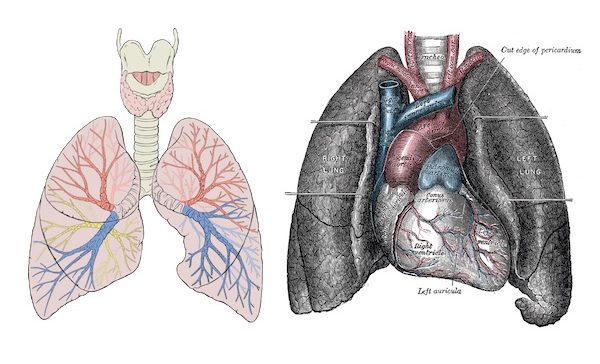Our lives depend on our lungs, and yet they’re so easy to forget about. Based on an average of 16 breaths per minute, an 80-year-old person will have taken nearly 675 million breaths in their lifetime – and how many were noticed? Most religious and spiritual practices in the world recognize mindful breathing as a path to meditation and enlightenment, and physical fitness experts agree that good breathing practices can confer all kinds of health benefits. Basically, taking care of your lungs is good for the mind, body, and soul. The first step to taking care of them is understanding how they work.
What do lungs do?
Every cell in your body needs oxygen. If a cell is deprived of oxygen, it dies quickly, usually in minutes. When you breathe in (inhale), your lungs are taking oxygen from the air and distributing it into your bloodstream. Similarly, every cell in your body produces carbon dioxide as a waste product. Too much carbon dioxide is toxic. Your bloodstream carries carbon dioxide away from your cells and back up to your lungs, where it leaves your body when you breathe out (exhale).
Simple, right? In goes the good air, out goes the bad. Inhale, exhale, repeat. But when you start to examine HOW the lungs give you life, you start to appreciate how complex the respiratory system actually is.
How do lungs work?
First of all, you have two lungs, in your upper chest, protected by your ribcage. Your lungs are not the same size. Your right lung is bigger and has three chambers called lobes. Your left lung is smaller and only has two lobes, because it has to leave enough room for your heart (which is slightly on the left, which is why you put your right hand over your heart a little left of center).
Your lungs are like an upside down tree with two main branches, enclosed in two big bubbles. The trunk of the tree is your trachea, or windpipe. It carries air from your nose and mouth down your throat until it reaches the two main branches, called bronchial tubes. Each bronchial tube serves one lung. The main bronchial tubes branch out into smaller bronchi and even smaller bronchioles. You have 30,000 of these airways, and the smallest are no thicker than a hair.
So far, we have an upside-down Y-shaped tree with thousands of branches. But what about leaves? In your lungs, every bronchiole ends in clusters of tiny round air sacs called alveoli. And just like leaves, alveoli are incredible structures. You have over 500 million alveoli, and their roundish shape creates as much surface area as the square footage of a good-sized apartment (550 to 800 ft2). They are responsible for taking the oxygen out of the air you inhale, and passing it on to your capillaries, which are the tiniest of your blood vessels. They also take the carbon dioxide from blood cells and send it back to the lungs to be exhaled. They can do this because they are incredibly tiny; in fact, the walls of each alveolus are only one cell thick! Same with the capillaries that they work with. This allows them to quickly exchange oxygen molecules for carbon dioxide molecules and let the blood keep pumping around your body.
So we have an upside-down Y-shaped tree covered with leaves that look like bunches of grapes. This is a delicate tree and needs protection. The two branch structures are covered by a membrane called a pleural sac, which also divides the five lobes of the lungs from each other. The pleural sac has two layers, the outer layer which separates the lungs from the ribcage and the inner layer which surrounds and protects the bronchial tree. They slide across each other when you breathe so the lungs don’t experience much friction.
Finally, we have our diaphragm, which is the muscle you’re feeling when you hiccup. The diaphragm is a big, thin muscle shaped kind of like an upside-down bowl directly underneath our lungs. When you flex your diaphragm, the bowl flattens out and creates a vacuum that allows air to suck into your lungs. Then, when you relax the diaphragm, it returns to its bowl shape and pushes air out of the lungs. Breathing “from your diaphragm” simply means that you are fully flexing and relaxing your diaphragm so your lungs fill and empty all the way.
Loving our lungs
Take a deep breath. Picture your upside-down tree branches filling with oxygen. Feel your blood delivering that fresh oxygen all over your body, all the way down to your toes. Breathe out. Feel your diaphragm and lungs relax. Your lungs are a wonderful miracle. Take care of them.



